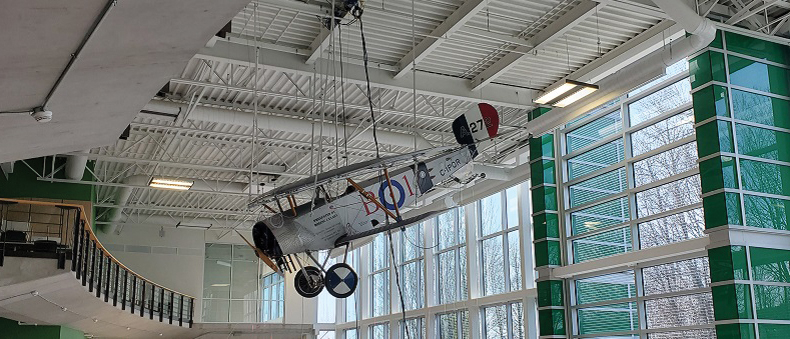Historic Nieuport XI biplane lands in Ottawa
By Lookout on Aug 13, 2021 with Comments 0
Emily Lindahl
D Air PA
––
It’s a bird, it’s a plane, it’s…well…it’s a bi-plane.
At NDHQ (Carling) in Ottawa, the Battle of Britain Building houses Royal Canadian Air Force (RCAF) staff, both military and civilian, and a VIP – a very important plane, a Nieuport XI.
This 7/8 scale replica of a Nieuport XI, C-IPOR comes with the nickname ‘Pokey’ and is on a long-term loan from the National Air Force Museum of Canada, located at Canadian Forces Base Trenton. The aircraft itself was donated to the museum in 2017 by a private collector from British Columbia.
This Nieuport XI participated in a commemorative flight at the 100th Anniversary of the Battle of Vimy Ridge in France, in 2017. The biplane also took part in the “Birth of a Nation Tour” across Canada for #Canada150. The aircraft was flown by currently serving pilot, Captain Brent Handy.
‘Pokey’ moved into the Battle of Britain – Building 7, March 27 when it was re-assembled and painstakingly hoisted to hang from the ceiling in the building’s three-story atrium a week later.
The process to hang the biplane securely without compromising its structure was an incredibly delicate process. Metal frames were built to take the aircraft’s weight safely.
The project was coordinated by LCol Jean-Pascal Paris, who is responsible for the Air Staff RCAF Artefacts aircrafts project, working in concert with the Vice Chief of the Defence Staff Carling Campus Project Director, Mark Ross, and BGIS Manager, Dave Sprung, as well as a team of aviation technical experts.
The Nieuport XI is also a tribute to Alan Duncan Bell-Irving of Vancouver, a Canadian who fought with the Gordon Highlanders during the First World War. In 1915, Bell-Irving was seconded to the Royal Flying Core (RFC) where he was posted to No. 60 Squadron.
He is known as the first Canadian RFC flying ace following his fourth and fifth aerial victories in September 1916, with a final count of seven aerial victories. He flew the Morane-Saulnier N single-seater, and then a Nieuport 17 fighter aircraft. On Sept. 14, 1916, Bell-Irving shot down an enemy observation balloon over Avesnes-lès-Bapaume, France.
Alan Duncan Bell-Irving was awarded the Military Cross on Oct. 20, 1916, and received a Military Cross Bar in January 1917. For his battle victories, France honoured Bell-Irving with the Croix de Guerre.
He was shot down four times, the last of which resulted in injuries that ended his active combat career. He finally relinquished his commission in 1919 due to health concerns.
But it was not the last that the Canadian military would see of Bell-Irving. During the Second World War, he joined the Royal Canadian Air Force, serving as the commanding officer at No. 1 Bombing and Gunnery School in Jarvis, and the RCAF Central Flying School in Trenton. When the war ended, he held the rank of Air Commodore.
Bell-Irving’s story was told in the book Gentleman Air Ace: The Duncan Bell-Irving Story. His legacy lives on with the Canadian Air Cadet program, the creation of which he played a key role. In 2010, to mark his role as one of the program’s founders, 135 Squadron, Royal Canadian Air Cadets was renamed 135 Bell-Irving Squadron.
There are two plaques on the Nieuport XI. The first one reads: Presented by Boeing Canada honouring Duncan Bell-Irving of Vancouver, First Canadian RFC Ace, 30 September 1916. The second reads: Presented by Air Canada Pilots Association honouring Duncan Bell-Irving of Vancouver, First Canadian RFC Ace, 30 September 1916.
––––
Filed Under: Top Stories
About the Author:






